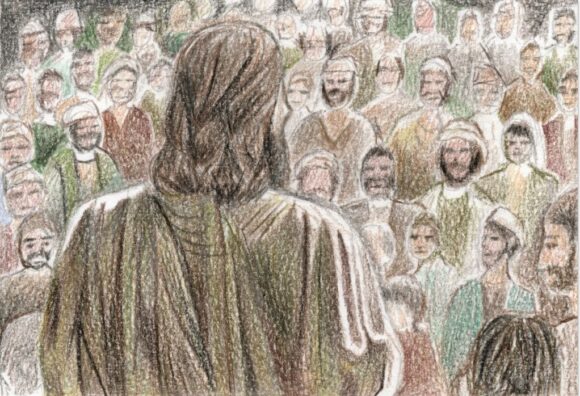THE BIBLE’S NEW TESTAMENT begins with the four gospels, which tell us of the life, death and resurrection of Jesus Christ. Each of the four writers was intent on bearing witness to his own knowledge of Jesus, and he wrote what he did under God’s inspiration so that we, the readers, should share that knowledge. Two of the writers, Matthew and John, had been close to Jesus from the time of his baptism through to his death and resurrection. This was their qualification to become apostles and to be tasked with taking the Gospel message to the ends of the earth. Each was able to write of the life of Jesus, his ministry and teaching, and the miracles, wonders and signs he performed.
But the writers wanted to do more than that—they wanted us to know who Jesus is, his nature and character, his compassion for people. Their aim was not just that we should know about him, but for us to feel that we begin to know him as a person, and so we might have a relationship with him.
Each gospel writer announces the status of Jesus early on. For Matthew he is Jesus Christ, son of David, son of Abraham (Matthew 1:1). For Mark he is the Son of God (Mark 1:1). In Luke’s gospel, through the words of the angel Gabriel to Mary, Jesus will be great and the Son of the Most High (Luke 1:32). For John he is the Word made flesh (John 1:14)—that is, conceived in the mind of God in the beginning and by his birth becoming flesh, a man dwelling among us, full of grace and truth, manifesting God’s glory as the only Son of the Father.
We may be familiar with the term Jesus Christ. “Christ” is not a name so much as a title. It is the Greek equivalent of the Hebrew “Messiah”, which means “anointed”—the Saviour, who was promised by the prophets and long awaited by the Jews (for example Isaiah 9:6).
Come and See
In the gospels people were invited to see Jesus. In Matthew’s record wise men saw a star in the east. They called it his star, and came to worship him (Matthew 2:2).
Later the Lord invited the people of his day to come to him: ‘Come to me, all who labour and are heavy laden, and I will give you rest’ (Matthew 11:28). Through Matthew’s writing the invitation is extended to us too.
Mark invites us to see the Master as a man of action, who acted swiftly in compassion for his fellows (for example the word ‘immediately’ occurs 35 times in Mark’s gospel).
Luke records how shepherds in the fields keeping watch over their flock by night were invited by an angel to be the first to see the new-born baby lying in a manger, who would be the Saviour, Christ the Lord (Luke 2:8–11).
In his first chapter John invites us to see Jesus: in the words of John the Baptist, ‘Behold, the Lamb of God’ (John 1:36). When the Bible uses the word ‘behold’ it usually announces something extraordinary, something to be taken special notice of. God was at last fulfilling the prophecy of Abraham, that God would provide Himself a lamb (Genesis 22:8). The two disciples who heard John say this were afterwards invited by Jesus to come and see where he was staying, and to be with him.
In John’s sixth chapter three words are used separately, but they describe a sequence: ‘come’, ‘see’, ‘believe’. These three words express the whole purpose of the Gospel. Those who come to Jesus will not hunger, and those who believe in him will not thirst, because the bread and water of life will always be available to them (v. 35). And, ‘This is the will of my Father, that everyone who looks on the Son and believes in him should have eternal life, and I will raise him up on the last day’ (v. 40).
See and Believe
We might be inclined to ask whether the gospels record the whole of the life and ministry of Jesus, and the answer is no. Although different gospels often record the same event, so we get different angles on that one event, the gospel records actually omit more than they contain. It has been calculated that the events recorded in the gospels account for about 70 days, whereas there will have been more than a thousand days in Jesus’ three and a half-year ministry. So we are just given a window into his life and work, being told the things that are most important for us to know. The Apostle John is clear about this: he records a small number of miracles, and tells us their purpose:
Now Jesus did many other signs in the presence of the disciples, which are not written in this book; but these are written so that you may believe that Jesus is the Christ, the Son of God, and that by believing you may have life in his name (John 20:30-31).
John Boulton


